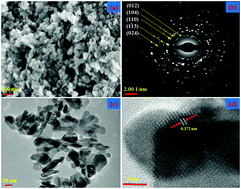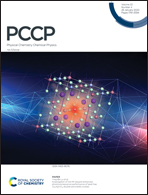Laser induced Fano scattering, electron–phonon coupling, bond length and phonon lifetime changes in α-Fe2O3 nanostructures†
Abstract
We have extensively studied the laser-induced Fano scattering, electron–phonon coupling, bond length and phonon lifetime of the α-Fe2O3 nanostructure prepared through a simple co-precipitation method. A noticeable red shift and asymmetry have been observed in the phonon modes of the prepared α-Fe2O3 nanostructure. The traditional assessment of asymmetric broadening and a red shift in the Raman spectra of a nanomaterial was due to the quantum confinement effect. In the present investigation, the red shift and the asymmetry in the phonon modes of the α-Fe2O3 nanostructure have been studied on the basis of the heating effect and Fano interference between the discrete phonon and the laser-induced electron plasma in the nanomaterial. The observed asymmetrical factors of the A1g(1) and Eg(4) phonon modes were positive and negative respectively and are seen to be decreasing with the laser power. The laser-induced surface temperature of the material has been studied using the Stokes/anti-Stokes method. The bond lengths of the Fe–O molecules present in the α-Fe2O3 nanomaterial increased and the calculated Fröhlich interactions decreased with the laser energy.



 Please wait while we load your content...
Please wait while we load your content...